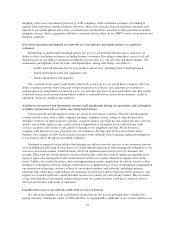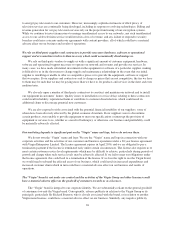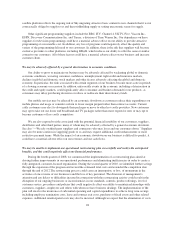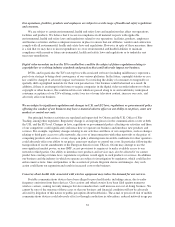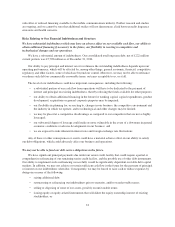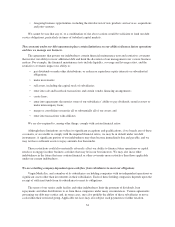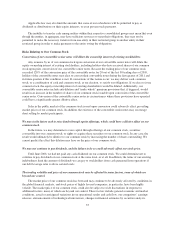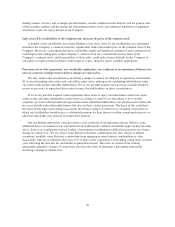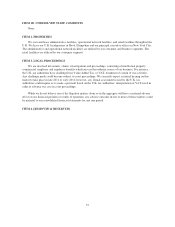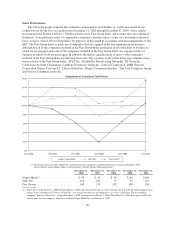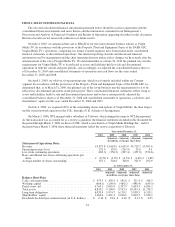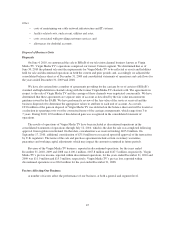Virgin Media 2010 Annual Report Download - page 38
Download and view the complete annual report
Please find page 38 of the 2010 Virgin Media annual report below. You can navigate through the pages in the report by either clicking on the pages listed below, or by using the keyword search tool below to find specific information within the annual report.Applicable law may also limit the amounts that some of our subsidiaries will be permitted to pay as
dividends or distributions on their equity interests, or even prevent such payments.
The inability to transfer cash among entities within their respective consolidated groups may mean that even
though the entities, in aggregate, may have sufficient resources to meet their obligations, they may not be
permitted to make the necessary transfers from one entity in their restricted group to another entity in their
restricted group in order to make payments to the entity owing the obligations.
Risks Relating to Our Common Stock
Conversion of our convertible senior notes will dilute the ownership interest of existing stockholders.
Any issuance by us of our common stock upon conversion of our convertible senior notes will dilute the
equity ownership interest of existing stockholders, including holders who have received shares of our common
stock upon prior conversion of our convertible senior notes. Because the trading price of our common stock
exceeded 120% of the conversion price of the convertible notes for 20 out of the last 30 trading days of 2010,
holders of the convertible notes may elect to convert their convertible notes during the first quarter of 2011 and
in future quarters if this condition is met. If conversions of this nature occur, we may deliver cash, common
stock, or a combination of cash and common stock, at our election, to satisfy our obligations. If we elect to issue
common stock, the equity ownership interest of existing shareholders would be diluted. Additionally, our
convertible senior notes include anti-dilution and “make-whole” premium provisions that, if triggered, would
result in an increase in the number of shares of our common stock issuable upon conversion of the convertible
senior notes. Conversion of the convertible senior notes in circumstances where these provisions have operated
could have a significantly greater dilutive effect.
Sales in the public market of the common stock issued upon conversion could adversely affect prevailing
market prices of our common stock. In addition, the existence of the convertible senior notes may encourage
short selling by market participants.
We may in the future seek to raise funds through equity offerings, which could have a dilutive effect on our
common stock.
In the future, we may determine to raise capital through offerings of our common stock, securities
convertible into our common stock, or rights to acquire these securities or our common stock. In any case, the
result would ultimately be dilutive to our common stock by increasing the number of shares outstanding. We
cannot predict the effect this dilution may have on the price of our common stock.
We may not continue to pay dividends, and the failure to do so could adversely affect our stock price.
Until June 2006, we had not paid any cash dividends on our common stock. We could determine not to
continue to pay dividends on our common stock at the same level, or at all. In addition, the terms of our existing
indebtedness limit the amount of dividends we can pay to stockholders from cash generated from operations if
our debt leverage ratio is above certain levels.
The trading volatility and price of our common stock may be affected by many factors, some of which are
beyond our control.
The market price of our common stock has been and may continue to be adversely affected by conditions in
the global financial markets, and stock prices of highly levered companies, in particular, have been highly
volatile. The market price of our common stock could also be subject to wide fluctuations in response to
additional factors, many of which are beyond our control. These factors include general economic and market
conditions, actual or anticipated variations in our operational results and cash flow, our competitors’ earnings
releases, announcements of technological innovations, changes in financial estimates by securities analysts,
35


